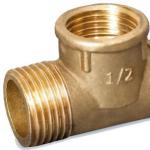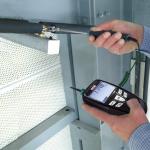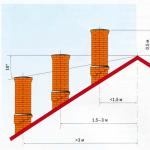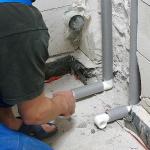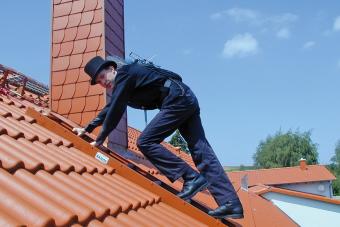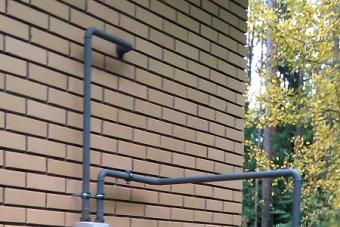Most heating devices, regardless of the type of fuel burned, need a chimney with good natural draft. But it is not enough to mount a channel for the removal of combustion products, it still needs to be properly operated so that the efficiency of the heat source does not decrease. In this article, we will consider how the periodic cleaning of the chimney is carried out with our own hands, which is a mandatory attribute of such operation.
When to clean your chimney
Immediately after installation, the inner walls of the gas ducts are clean and smooth. After a while, the stove chimney begins to be covered from the inside with a thin layer of volatile particles contained in the combustion products - soot.
This is especially true of the walls of brick pipes, whose roughness is initially great, no matter how hard you try to lay each brick with the smooth side inside the channel.
Many online publications write that cleaning of chimneys and ventilation ducts is necessary, since over time their working section decreases due to a thick layer of soot. This is true, only in real life it will take at least 5 years before any significant narrowing of the passage occurs. The force of natural traction may decrease a little earlier, and here's why.
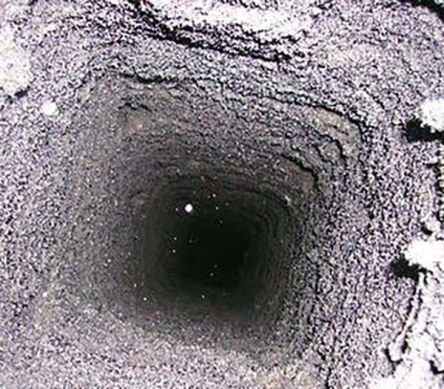
If the soot is not periodically removed, then the unburned particles deposited on the walls increase their roughness more and more, the force of resistance to the flow of gases increases due to friction. The thrust force is expended to overcome this resistance, as a result, the speed of movement of the flue gases decreases, which means that the consumption of air for combustion also decreases. The process slows down, the temperature in the furnace drops. It's getting colder in the rooms and what do we do instead of cleaning the chimney in the bath or house?

That's right, we throw in more firewood or coal, and in the boilers we increase the heating of the coolant by turning the knob. At the same time, do not forget to open the blower door wider. As a result, the combustion process intensifies, and then this is what happens:
- flue gas temperature rises; due to this, their speed of movement increases and traction is restored;
- we get the same amount of heat in the house with increased fuel consumption, since its lion's share flies into the chimney along with flue gases;
- the further, the layer of soot increases faster;
- from hot gases, soot in the pipe smolders and ignites, which sometimes leads to a fire.

Note. Constant cleaning of the chimney in a bathhouse or in a private house is required when the heat generator is solid fuel. The flue pipes of high efficiency boilers, which include gas ones, are more likely to suffer from another problem - the formation of condensate.
Now you can reasonably list all the signs indicating that it is time to clean the chimney from soot:

- you notice that you are burning more wood or coal to get the same amount of heat as before;
- burning soot always emits black smoke. Accordingly, the second sign that it is necessary to clean the chimney in a bathhouse or cottage is black smoke from the chimney. If it falls even when dry hardwood firewood is loaded into the oven, then this layer of soot burns out on the inner walls of the channel.
- as the channel section "overgrows", the color of the flame in the furnace changes from orange to dark red.

In accordance with the recommendations, preventive cleaning of the chimney pipe and stove flues is carried out once a year, at the beginning or end of the season. By doing it on time, you will avoid the need for major cleaning, and in some cases, partial disassembly of the channel.
Cleaning methods
To clean the chimney in the furnace yourself, you can use several methods:
- resorting to various folk remedies;
- with the help of modern chemistry designed for these purposes;
- calcination of the pipe;
- in the traditional mechanical way, as chimney sweeps do.
Note: The first 3 methods are suitable when you need to clean flue ducts with a small degree of pollution, as a preventive measure. When the flue is thoroughly “overgrown” with soot, only mechanical cleaning will help.
The essence of the first 2 methods is as follows: one or another chimney cleaner is placed in a melted sauna stove or solid fuel boiler and simply burned. Under the influence of released active substances, the soot layer decomposes, part of it flies out with smoke, and the other falls down to the bottom of the channel. There is only one drawback of the method: in calm weather after the procedure, black flakes cover the entire yard.

Self-cleaning the chimney from soot by calcination is an unsafe event. Before proceeding with it, you need to make sure that all channels are reliable and tight, otherwise you can easily start a fire. Ignition is the direct combustion of soot in a pipe, achieved due to the high temperature of the combustion products. Dry logs of aspen or white acacia are loaded into the firebox, which give a strong heat when burned.
This means for cleaning chimneys from soot requires the operation of a heat generator or stove in maximum power mode, for this it is necessary to provide the greatest air supply and do not forget to fully open the chimney damper. Gases with temperatures up to 600 ºС pass through the channel, causing the soot to burn.
Advice. Before calcining a brick chimney with your own hands, you must definitely check the section of the pipe passing through the attic space. It is not uncommon for mice to make holes in the canal walls in search of warmth in winter. For this reason, there were many fires.
How to heat the stove to clean the chimney
One of the most common folk methods is to clean the chimney with potato peels. Everything is simple here: half a bucket of potato skins is poured onto the hot coals of the firebox. The starch released in the process favors the separation of carbon deposits from the walls of the channel, after which it crumbles down, and the other part flies out. The same effect is produced by burning ordinary table salt together with firewood.

If you can’t clean the chimney with folk remedies and the soot remains in place, then you can try to burn modern chemical compounds. These include a Czech product in the form of a powder called "Cominicek", "Glas-Smoke" and the like. They must be used in accordance with the dosage instructions. But the essence is the same as with potatoes: the cleaning powder in the right amount is placed on hot coals without opening. Soot is decomposed by chemically active substances, while a significant increase in the temperature of the gases does not occur.
Advice. Do not try to increase the dose, it will not lead to anything. Instead, it is better to repeat the operation again.

There is another common chemistry for cleaning bath and heating stoves, fireplaces and boilers. This is the so-called catalyst that provokes the combustion of soot without a significant increase in temperature. It is produced in the form of a log in a sealed package, called "Chimney Sweep". It is placed in the firebox both together with firewood and independently, only in the latter case the package must be set on fire from both ends. The process takes 90 minutes and, according to reviews, it helps well with soot.

Important. Regardless of which cleaning agent you have chosen - chemical or folk, after the procedure it is necessary to open all the doors to service the furnace or boiler and thoroughly clean the soot from the gas ducts.
Means for mechanical cleaning of chimneys
When the degree of clogging of the channels has reached its apogee and they are almost half covered with soot, and the chemical cleaning of the chimneys has exhausted itself, there is no other way but to remove all the deposits manually. This is a method of capital removal of solid fuel combustion products that have firmly settled inside the pipe. Here you can’t avoid a lot of labor, and you’ll have to get pretty dirty. But first you need the following set of tools and fixtures:
- brush with metal bristles;
- brush for cleaning the chimney pipe with a load and a set of extensions for extending the handle;
- scraper, poker;
- core on a rope;
- lifting and safety devices (ladders, ropes, mounting belts).

Advice. The diameter of the core to remove plugs should be 2/3 of the size of the internal section. It is not recommended to use weights and dumbbells that can get stuck between the walls. For a round pipe, a brush is used for cleaning 15-20% larger than its diameter, and for a rectangular pipe, a brush with a bristle of steel wire is used.

Having chosen a good fine day, they close all the doors of the stove in the house, and the fireplace portal is hung with foil, the valves are fully opened. Having got out on the roof, they tie insurance and proceed to the procedure. Blockages and plugs that cannot be reached through the top are pushed down with the help of the core. The projectile should be used carefully so as not to damage the surface of the walls. If the soot is very dense and cleaning the stove with a brush does not give results, then it is first cleaned off with a scraper.

Having thoroughly cleaned the pipe, they go to the channels of the gas ducts of the furnace, and only then - to the furnace itself and the blower. At the fireplace, the smoke tooth and the smoke box cap are cleaned from the inside, and then the firebox. Steel pipes after removing the main soot can be cleaned with a brush made of nylon or polypropylene.

Conclusion
In order not to bring it to such an extent that only a core and a ruff for cleaning the chimney will help, it is necessary to do preventive cleaning with the help of chemical and folk remedies, and also not to throw plastic and other household garbage into the furnace. It is undesirable to constantly burn damp firewood, then the likelihood that you will have to do the work of a chimney sweep will be much lower.
